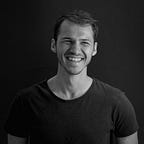Tom Roohan On Going With the Flow
Tom Roohan is a non-award-winning (his words not ours) Motion Designer from Brisbane, Australia. We chatted with Tom about his latest short film “Flow” and the exploratory process that sparked him to learn something new.
It sounds like COVID-19 had a huge impact on the creation of this project.
Yes, that’s right. The idea for this animation had been rattling around in my head for a couple of months before COVID. During this time I designed several style frames to help me visualise something worth pursuing.
I wanted to convey a grand sense of scale throughout the piece. There needed to be a contrast between super wide shots and close-up momentum. These requirements made me feel like it would be a technical challenge. I delayed starting any production on this until COVID came along. The pandemic presented a unique opportunity for me to leverage the extra time that I had suddenly been given. My travel plans, like many others, were ruined –so this project took me on a different kind of journey.
One thing we love at Breeder is taking standard processes and pushing them into unknown territory — you used Houdini in a very interesting way to create this film.
There’s no doubt Houdini is an intimidating piece of software. It can be overwhelming to dive into it and try to create. I suppose I like the way you can organise scenes in it.
I was able to cluster my scene assets into easily identifiable groups. I was able to design most of the scene procedurally. For example, the boat animation was keyframed. Once I had this keyframe data I was then able to manipulate all of the curves and movements to extrapolate the wavy watery shapes from that. So in a sense, all of the watery waves stem from that sailboat being animated. The waves could then take on a life of their own by being processed through solvers and manipulated by noise –even turning them into cloth and applying forces.
In the back of my mind, it was always comforting to know that if I had to go back up the chain and alter the boat animation then all of the waves would inherit the adjustments.
How long did it take you to create this film? What did you learn?
I’m not entirely sure how long it took. I’d spend a couple of weeks here and there when I felt inspired. The process of working on this became very meditative: I spent hours making sure I was happy with the animation curves in the beginning scene. I learned a lot about managing larger scenes, scale and compositing while working on this. There is a bit of everything happening in it including some particle sim and cloth for the sails!
What has the response been like?
The responses have been really positive. I think in general people feel like there is a nice positive meaning or concept behind the piece. It is somewhat abstract and so I think people can associate their own feelings towards it. I shared the project on a variety of platforms; for a little while now I’ve been posting more on LinkedIn.
Surprisingly, LinkedIn gave me the most meaningful engagement from viewers. The audience there doesn’t necessarily get to see this type of stuff all the time.
For example, I had an HR person, who I didn’t know, say they thought it was a very important message and was thoughtfully created. To me, that means a lot.
What pieces of motion have you really loved recently?
I’ve really liked the work of Adam Maurer. I’ve been following the development of the Cavalry app over the past couple of years and seeing what he has been able to create in it is really amazing. His “30 Days of Cavalry” project was really insightful and incredible that he shared the working files.
Coat Of Arms has also caught my eye with their design work for Mountwest.
If you want to follow more of Adam’s work (we know we will be), you can hit up his Website, Vimeo, Linkedin, Twitter and Instagram. Also, check out Coat of Arms on their Website, Instagram and Vimeo.
Good Chats is a blog run by Good Moves — the home of the creme de la creme of motion design, curated by Breeder. To be the first to know when the next interview’s out, subscribe here.
